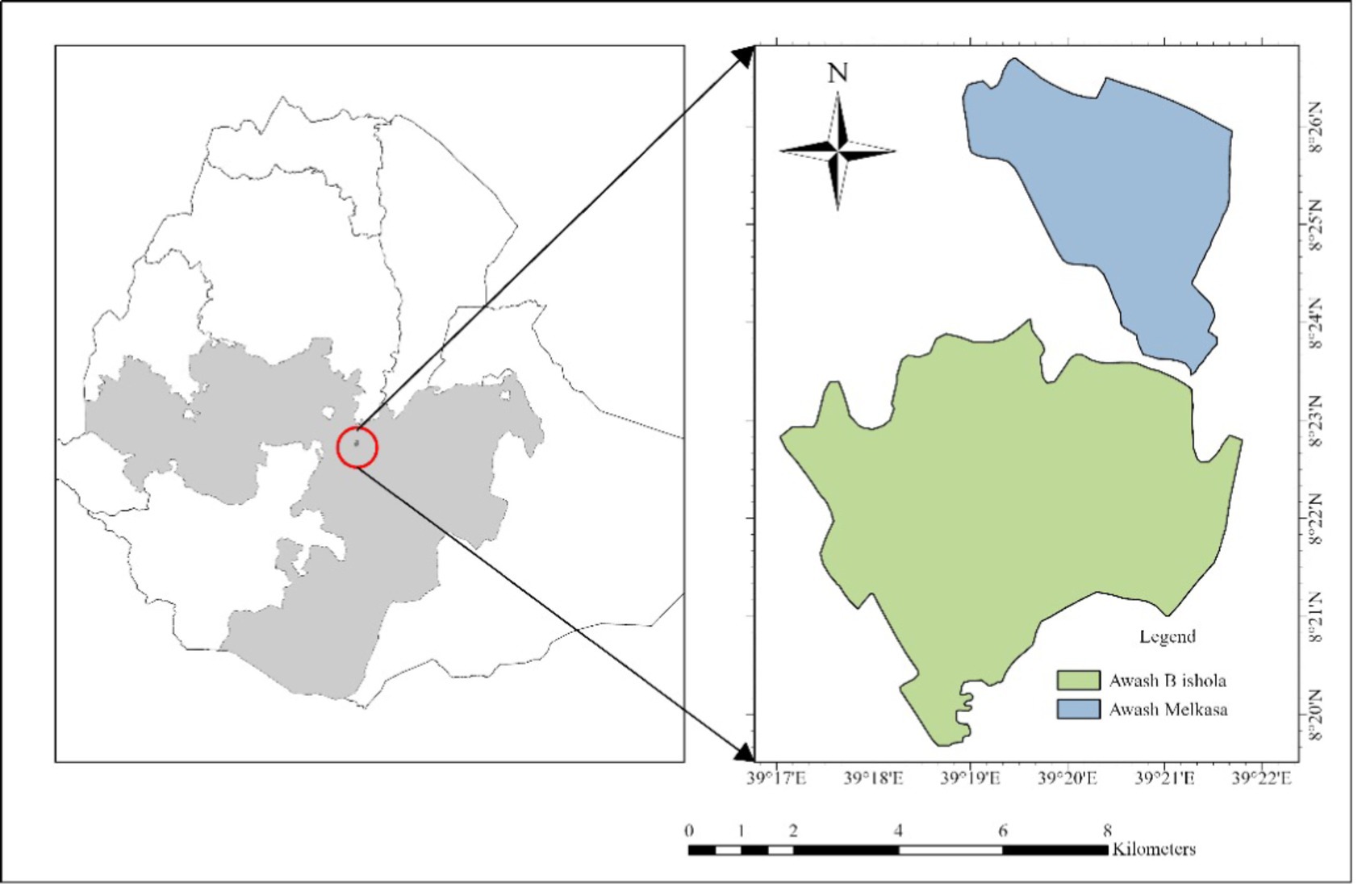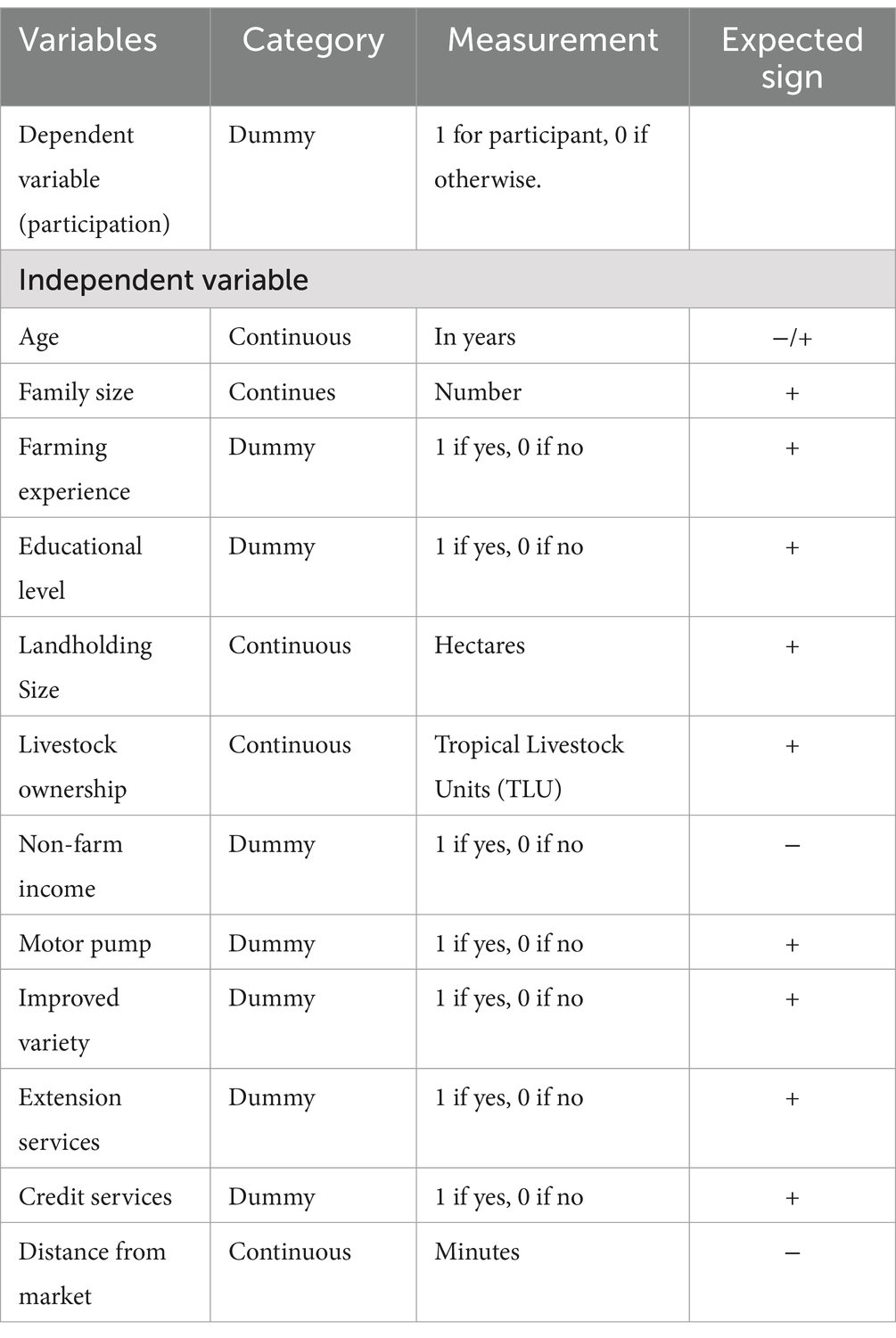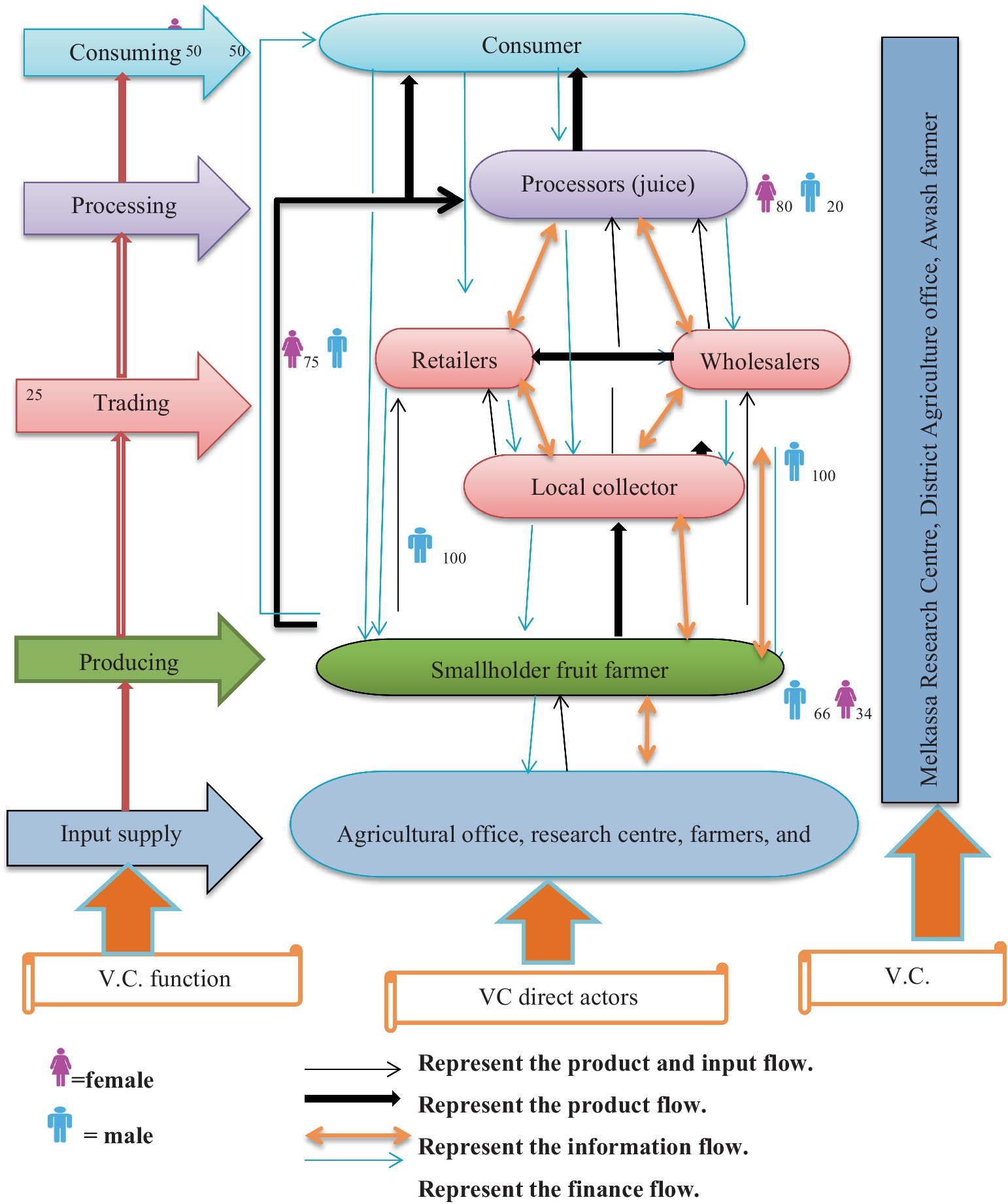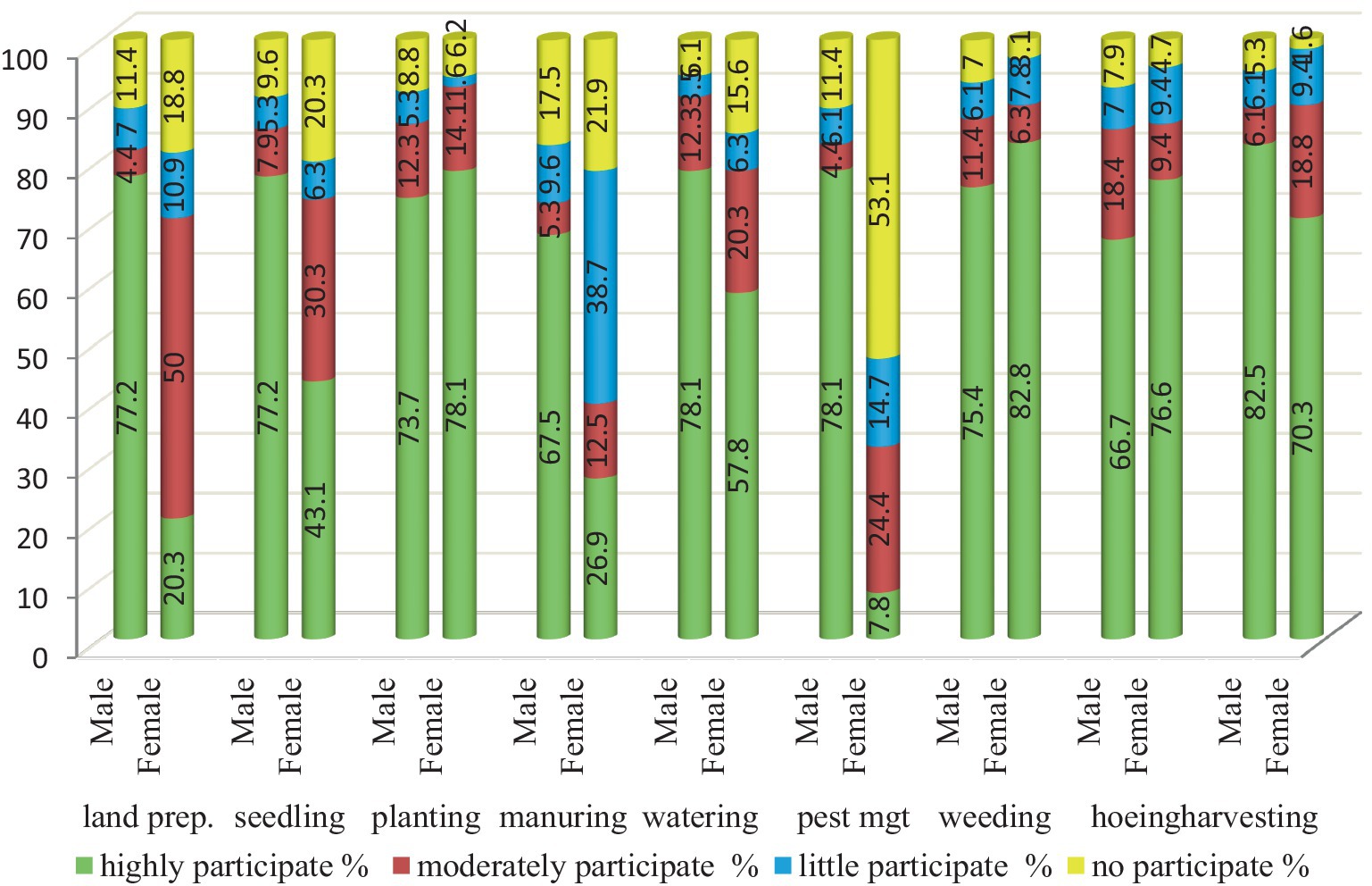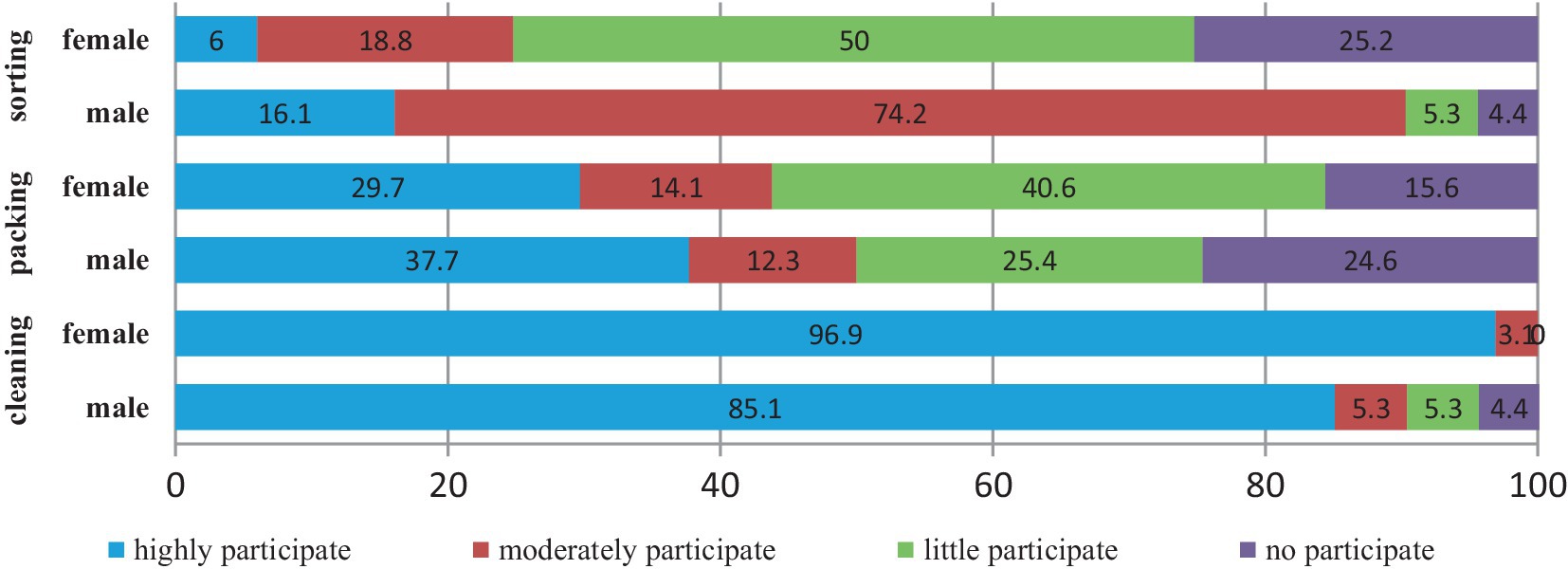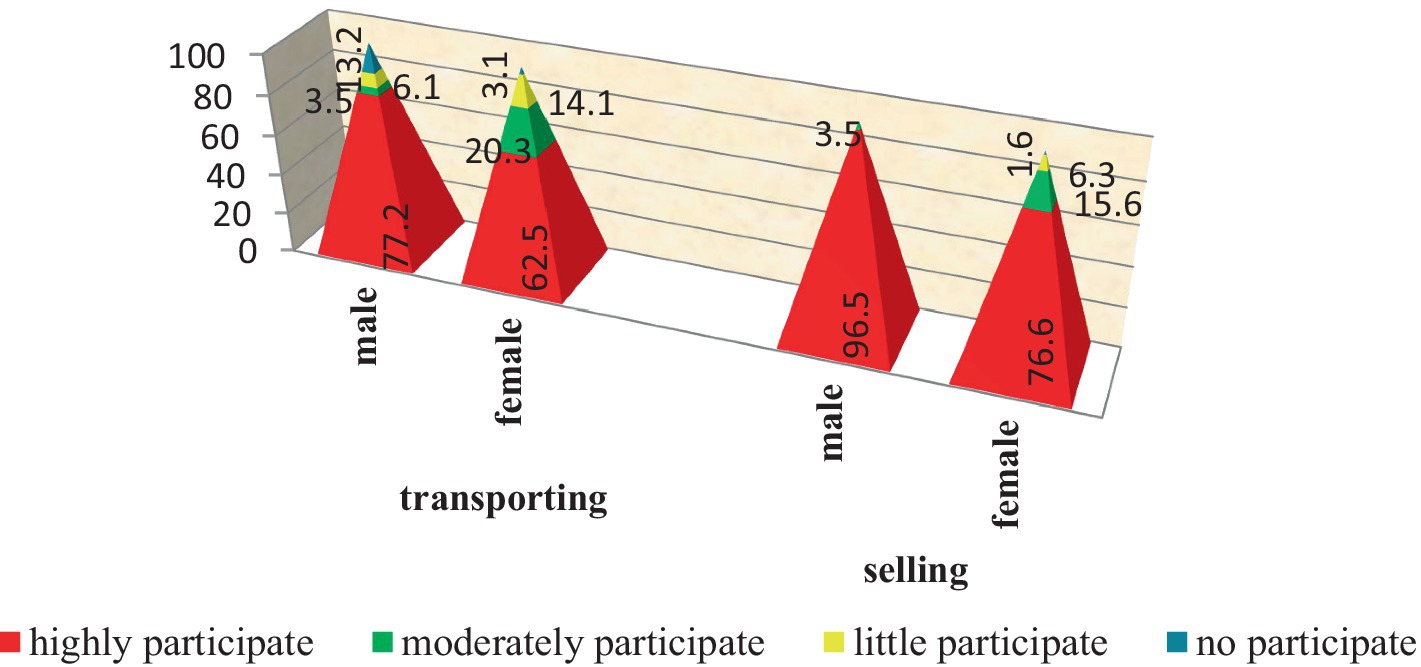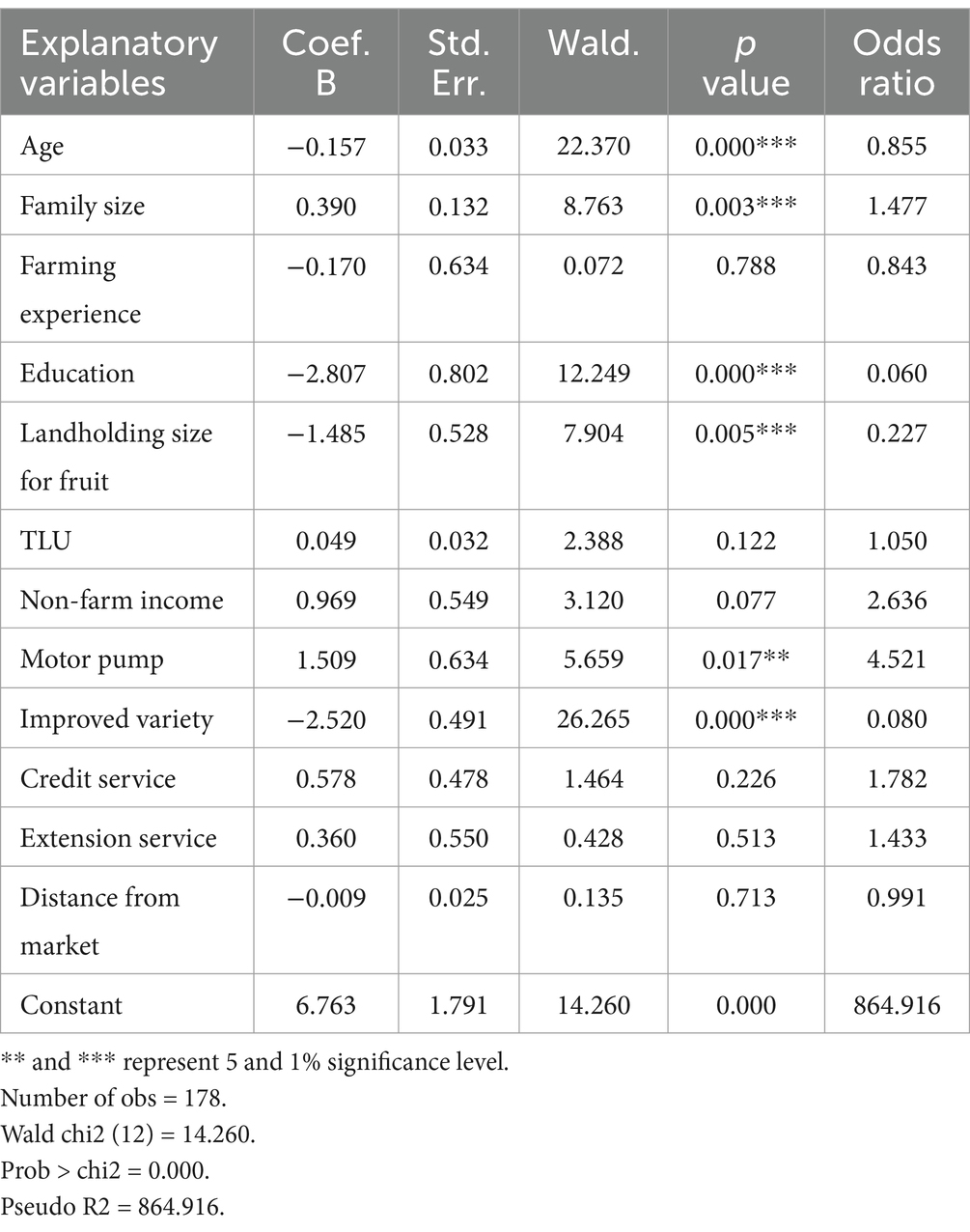- 1Ethiopian Forestry Development, Addis Ababa, Ethiopia
- 2Hawassa University, Awasa, Ethiopia
- 3Research Institute for Environment and Livelihood, Charles Darwin University, Darwin, NT, Australia
- 4University of Natural Resources and Life Sciences, Vienna (BOKU), Institute of Forest Ecology, Vienna, Austria
Despite the economic significance of fruit tree-based agroforestry in Ethiopia, gender considerations throughout the value chain activities are still underexplored. This study evaluated gender roles within the fruit tree-based agroforestry value chain in the Dodota district of Oromia Regional State, Ethiopia. We used a random sampling technique to collect primary data from 178 respondents. The FAO gender-sensitive value chain analysis framework and the Binary Logit model examined women’s involvement in the fruit value chain. The results indicated that women actively participated in various stages of the fruit value chain in the study area, functioning as producers, retailers, and processors. Our finding highlighted those women in the study area played an essential role in agriculture activities such as land preparation (81.2%), seedling preparation (79.7%), planting (93.8%), manuring (78.1%), watering (84.4%), pest management (46.9%), weeding (96.9%), and hoeing (95.4%) and harvesting (98.5%). However, women’s engagement in the fruit value chain is subject to different socioeconomic factors, such as access to improved varieties, age, education level, family size, motor pump ownership, and landholding size. These findings emphasize the need for gender-inclusive policies that improve women’s access to productive resources and decision-making power within fruit tree-based agroforestry value chains. The study highlights critical insights and pathways for promoting and advancing gender equity in agroforestry systems and guiding policy interventions.
1 Introduction
Agroforestry, the integration of trees and shrubs into agricultural landscapes, is increasingly recognized as a sustainable land management strategy and a climate-smart production system, offering the potential for climate change mitigation (Yirga, 2019). Gender dynamics significantly influence the management and use of these systems. While agroforestry presents opportunities for women, who often face disproportionate constraints in accessing resources and technologies (Kiptot and Franzel, 2012) their specific roles and influence within these systems require in-depth investigation. Agroforestry products such as fruits, species, and fodder are often vital for women, particularly those with limited access to land, credit, and other assets, contributing to their livelihoods and food security (Ingram et al., 2016).
Although gender issues in agricultural production have been widely studied in Africa (Carlsen and Bruggemann, 2022) contribution of gender within agroforestry systems, especially fruit tree-based agroforestry, is still underexplored (Kiptot et al., 2014). Kiptot and Franzel (2012) emphasized the need to integrate gender considerations into sustainable agricultural practices. Addressing gender imbalances is not only essential for equity but also contributes to poverty reduction, food security, environmental sustainability, and climate change mitigation (Degrande and Arinloye, 2014). This aligns with broader development agendas promoting the interconnectedness of gender equality and sustainable development, e.g., UN Sustainable Development Goal 5 (Carlsen and Bruggemann, 2022). This study adopts a gender-sensitive value chain analysis framework (Lentink et al., 2016) to examine women’s and men’s roles, responsibilities, and benefits distribution within fruit tree-based agroforestry systems.
Fruit-tree-based agroforestry practices have recently expanded to different areas of Ethiopia, driven by their high economic benefits (Getahun, 2015). Fruit trees are particularly valuable as they generate higher incomes compared to other agroforestry practices, making them a powerful tool for women’s economic empowerment. Additionally, the fruit value chain, which spans cultivation, processing, and marketing, offers multiple entry points for women’s participation, enhancing their financial independence. Beyond economic gains, these practices are crucial in improving nutrition and food security, benefiting women and their families (Dabessa and Jaleta, 2023). Several studies have examined gender roles in agroforestry practices, primarily focusing on the roles of women and men within these systems (Owitti, 2015; Sahilu, 2017), add the reference linked with this Peralta (2022). While these studies have primarily concentrated on gender roles in management and specific activities like collection and marketing at the household level, there is a need to broaden the scope to gain a more nuanced understanding of individual positions within the system. Examining gender relations within the fruit value chain, particularly in regions like the Dodota district, is essential for acknowledging women’s involvement and workload.
The Dodota district in Ethiopia holds excellent potential for producing a diverse range of fruits, vegetables, and cereal crops, with agroforestry products serving as vital sources of income and food for local farmers. Despite this, a noticeable lack of literature focuses on the value chain analysis of fruit tree-based agroforestry practices through a gender lens. To address this knowledge gap, we conducted this research with a focus on two questions:
1. Where do gender differences exist within the fruit-tree-based agroforestry value chain in the Dodota district?
2. What factors influence women’s participation at different stages of this value chain?
This study provides empirical evidence on women’s roles and the factors shaping their participation in fruit tree-based agroforestry in the Dodota district by employing a gender-sensitive value chain analysis framework and econometric modeling (Figure 1). The findings contribute to a deeper understanding of gender dynamics in these systems, offering insights for developing gender-responsive policies and interventions to enhance women’s empowerment and promote sustainable agroforestry development.

Figure 1. Conceptual framework on factors influencing and promoting women’s participation in the fruit tree-based agroforestry value chain.
2 Materials and methods
2.1 Description of the study area
The research was conducted in the Dodota district of Arsi Zone, Oromia Regional State, Ethiopia. It is located 125 km southeast of Addis Ababa, the capital city of Ethiopia. It is situated in the great East African Rift Valley at 8° 24′ N latitude and 39° 19′ 59″ E longitude, with an elevation ranging from 1,400 to 2,500 meters above sea level. The district is bordered by Sude to the southeast, Tena to the south, Hitosa to the southwest, Jeju to the east, and Misraq Shewa zone to the north (Dodota District Agriculture Office, 2022) (Figure 2).
2.2 Sampling and sampling techniques
Both probability and non-probability sampling methods were utilized to choose the sample kebeles and participants. Kebele is the smallest administrative unit in Ethiopia. Out of the 15 kebeles in the area, Awash-Bishola and Awash-Melkassa were purposefully selected due to their potential, suitability, and accessibility for fruit production and marketing. The sample participants were randomly selected, starting with farmers, including traders (retailers, wholesalers, and processors) and input dealers. The sample size of households was determined using following equation (Cochran, 1977).
Where: n = The sample size H.H.s used for the study.
N = Total number of H.H.s in the two selected kebeles (520 + 900).
e = Maximum variability or margin of error assumed to be 7% (0.07).
A total of 178 household heads were randomly selected across the two districts. In addition, three wholesalers, twelve retailers, ten processors, five input suppliers, five rural collectors, and twelve consumers were randomly selected using the lottery method.
2.3 Data sources and data collection methods
The data for the study were collected from both primary and secondary sources. Primary data were collected using questionnaires, observations, and interviews. Secondary data were collected by reviewing relevant literature on related topics.
2.3.1 Household survey
The semi-structured questionnaire employed in this study was designed to gather quantitative data on the socioeconomic characteristics of the households within the study area. This questionnaire was carefully crafted to include a mix of open-ended and closed-ended questions, allowing for a structured yet flexible approach to data collection. This method gathered detailed information on various aspects of the sampled households’ socioeconomic profiles and valuable insights into the demographic, economic, and social factors influencing the study area.
2.3.2 Key informant interviews
Seven key informants were selected for the interviews, including three researchers from the Awash-Melkassa Agricultural Research Institute, an agricultural expert from the Dodota District Agricultural Office, a marketing expert from the District Trade and Marketing Office, and an expert from Farmers’ Training Centre from each kebele. The selection of the key informants was purposive and aimed at gathering diverse perspectives and expertise on agroforestry practices in the Dodota district. The three researchers from Awash-Melkassa Agricultural Research Institute contributed their research experience. The agricultural expert from the Dodota District Agricultural Office provided local context and practical knowledge. The marketing expert from the district Trade and Marketing Office added a market-oriented perspective, and the Farmers’ Training Centre representatives shared valuable grassroots insights, reflecting community-level experiences and challenges.
2.4 Method of data analysis
The data analysis process involved descriptive statistics, a gender-sensitive value chain analysis framework developed by the Food and Agriculture Organization (FAO), and regression analysis. Quantitative and qualitative data were processed using the Statistical Package for the Social Sciences (SPSS) version 25.
2.4.1 Descriptive statistics
We summarized and presented the data clearly and concisely using descriptive statistics. This analysis helped understand the participants’ demographic composition and socioeconomic dynamics, contributing to a more comprehensive understanding of the gender-based fruit value chain.
2.4.2 Gender-sensitive value chain analysis
Gender-sensitive value chain analysis was conducted in this study to explore women’s roles in the fruit value chain. The approach was based on FAO’s Gender-Sensitive Value Chain (GSVC) guiding framework from 2016. This framework was designed to help practitioners address gender disparities and promote gender equality within agricultural value chains. The analysis began by mapping out the value chain while considering gender issues and identifying key actors, partners, and clients involved. Subsequently, the study delved into gender-specific aspects such as roles, resource access, benefit control, and the impact of gender on various factors. By systematically analyzing value chain data through a gender lens, this research provided a comprehensive understanding of gender dynamics within the fruit value chain.
2.4.3 Regression analysis
The logit model examined the factors influencing gender participation in the Fruit Tree-Based Agroforestry (FTBAF) value chain. When considering whether a woman participated in the Fruit Value Chain (FVC), the response is typically binary—either yes or no. In cases where the dependent variable is dichotomous, taking values of zero or one, using a logit or probit regression model is essential (Gujarati, 2004). This study utilized a logistic distribution function, specifically a binary logit model, given the dichotomous nature of the dependent variable. 1 indicated a woman’s participation in the FVC, while 0 signified non-participation. The relationship between the probability of the event (𝑃𝑖) and the explanatory variable (Xi) is nonlinear in this context (Gujarati, 2004) highlighting the complexity of gender participation dynamics in the FTBAF value chain.
Following the methodologies outlined by Gujarati (2004) and Hosmer and Lemeshow (1989), the logistic distribution function for participating in the Fruit Value Chain (FVC) can be specified as follows:
Where:
(Pi) is the probability of women’s participation in the value chain.
(Xi) is the explanatory variable explaining the probability of participation in the FVC.
(i) is an individual household observation.
Where equation one is the logistic distribution equation.
Let us consider Z.I. = β1 + β2Xi or replaced by in the first equation, then obtain Equation 2.
Zi is a function of explanatory variables (Xi) between −∞ and + ∞, and Pi is between 0 and 1 (where pi is equal to one the probability that women” who participated in the value chain of FTBAFP), and 1−Pi is the probability of non-participation.
1−pi = then, the probability of women not practicing in FTBAF can be explained in Equation 3 as follows:
Equation 4 can be obtained by dividing the probability of women participating in the FTBAF value chain by those not participating. So, the equation is.
Taking the natural logarithm of both sides of the equation will result in what is known as the logit model, as indicated below in Equation 5.
The disturbance term 𝜀i is considered in the logit model. Therefore, the model employed has the following form with the error term:
Where is the intercept.
… are the slope parameters in the model. The slope coefficient can tell the change log odds in favor of participating in the FVC change as an independent variable.
Therefore, the above econometric model analyzed the factors affecting women’s participation in the FVC (Table 1).
3 Results and discussion
3.1 Value chain analysis actors
3.1.1 Direct actors
The agroforestry-based fruit production value chain in the study area comprises key players, including input suppliers, producers, local collectors, wholesalers, retailers, processors, and consumers. While each actor plays a distinct role, they can be broadly classified into primary and support categories based on their contributions throughout the value chain. Our survey indicated that more women were involved in retailing (75%) and processing (80%) activities (Figure 3). Most of the local processing businesses in the study area were owned and managed by women. In contrast, women in the study area did not participate in input supply, collection of fruits from farmgate, and wholesaling activities. A review by Ingram et al. (2016) Gender and Forest, Tree, and Agroforestry Value Chains highlighted that female dominance was recorded at the collector, processor, and small-scale trader stages. The review indicated that women are primarily active in the upstream and downstream ends of chains: Harvesting and small-scale retail trade, and those men tend to run larger businesses.
3.1.2 Value chain supporters (direct actors)
Value chain supporters provide various supportive services such as research, training, and extension services. The main supporters of the value chain in the study area were the Melkassa Agricultural Research Centre, the District Agriculture Office, and the Farmers’ Training Centre. The Melkassa Agricultural Research Centre is involved in promoting an improved variety of fruit seedlings (with high yields and resistance to bacterial and fungal diseases) for broader adaptation. The district agricultural office provides agricultural extension services and relevant technical support on seedbed preparation, fertilizer application, fruit crop protection, and postharvest handling. On the other hand, farmers regularly attend agronomic and horticultural crop production training at the Farmers’ Training Centre.
3.2 Gender role in fruit production and marketing
3.2.1 Gender division of labor in fruit production
Production is essential to any crop value chain (Hadebe and Msuya, 2016). Production activities in this study included land preparation, seedling preparation, planting, fertilization, watering, pest management, weeding, hoeing, and harvesting. Figure 4 indicated that females and males participated in farm activities at various levels.
3.2.1.1 Land preparation
The results (Figure 4) indicate that male-headed households were more involved in land preparation than female-headed households in the study area. This gap is mainly due to the physically demanding nature of land preparation, which requires intensive manual labor. Consistent with our findings, Abebe and Mulu (2017) revealed that men contribute more to land preparation (clearing and ploughing) than women.
3.2.1.2 Seedling preparation
The study results indicated that male-headed households were more involved in seedling preparation than their female counterparts. Our findings are consistent with those of Feyisa and Megersa (2020) who found that males participated more in seedling preparation than females.
3.2.1.3 Planting
The survey results (Figure 4) revealed that 93.8% of female-headed households actively participated in planting, compared to 91.3% of male-headed households. This suggests a strong involvement of women in tree-planting activities. Similarly, Abebe and Mulu (2017) found that women tend to lead the planting and managing of fruit trees, particularly in home-garden agroforestry systems.
3.2.1.4 Manuring
Of all female-headed households, 78.1% participated in manuring. On the other hand, of all the male-headed households, 82.4% of them participated in manuring. Key informants indicated that men handled the application of manure to fruits.
3.2.1.5 Watering
The fruit was predominantly cultivated in the study area using an irrigation system from the Awash River. Most of the farmers in the study area used motor pumps, either owned or rented by other farmers. According to the survey results, 84.4% of female-headed households participated in watering, while 93.9% of male-headed households were involved in the same task (Figure 4). Research has shown that women typically contribute 70–90% of the labor required for watering and manuring, which are often considered their primary responsibilities (Hengsdijk et al., 2021).
3.2.1.6 Pest management
In the study area, male-headed households were more actively involved in pest management than female-headed households. As shown in Figure 4, 88.6% of male-headed households participated in pest management, whereas only 46.9% of female-headed households participated. As for the key informants, women were not allowed to use chemicals because the chemicals could affect their reproductive organs. Consistent with our findings, Abebe and Mulu (2017) revealed that men have experience with fertilizers and chemical applications.
3.2.1.7 Weed management
Female-headed households had a higher level of participation in weed management than their male-headed counterparts. Out of the whole sampled female-headed households, the survey showed that 96.9% of the females participated in weed management. On the other hand, of all male-headed households, 92.9% of them participated in weeding. This result agrees with Tekalign et al. (2020), who noted that women are primarily engaged in weeding and harvesting. Another finding by Hengsdijk et al. (2021) showed that women dominate farming activities, including weeding.
3.2.1.8 Hoeing
Figure 4 indicates that 95.4% of the female-headed households participated in hoeing activities. However, of the total male-headed households, 92.1% participated in hoeing. The survey indicated that women were the dominant participants in hoeing. This is because men focus on cultivating vegetables and cash crops while hiring daily workers to assist with hoeing.
3.2.1.9 Harvesting
The survey data revealed that males participated more actively in fruit harvesting than females. As shown in Figure 4, 98.5% of the male-headed households participated in harvesting, whereas 94.7% of the female-headed households participated in fruit harvesting. However, due to the high height of the fruit trees, most of the harvesting activities were performed by males. Our findings agree with those of Abebe and Mulu (2017), who found that men mainly harvested home garden products. Additionally, Asfaw et al. (2024) who revealed that women participate in farming activities such as weeding, planting, harvesting, and threshing.
3.2.2 Gender-based division of labor in value-adding activities
Value addition is the primary component of value chain studies and arises from cleaning, sorting, grading, packaging, storing, transporting, and processing. In developing countries, the lack of agro-industrial expansion has primarily contributed to the stagnation of value-added for market-oriented crops (Mossie et al., 2021). Sorting, cleaning, and packing were the central value-addition practices adopted by both males and females.
3.2.2.1 Cleaning
Farmers participate in various activities to ensure the cleanliness and quality of their fruit. These activities include caring for mature fruits to prevent breakage and cracking during harvest, using manure smoke on farms to protect fruits from frost during cold periods, and washing fruit leaves with water, particularly on papaya fruit farms. This is necessary because the area has sandy soil, which can be deposited on the fruit leaves during windy times, causing them to burn. Therefore, farmers should wash their fruit leaves to alleviate this issue. The survey results of all the female-headed households indicated that 96.9% had high participation, whereas 3.1% had moderate participation in cleaning.
3.2.2.2 Packing
The results of this study (Figure 5) indicated that 37.7% of male-headed households had high participation, and 12.3 and 25.4% had moderate to low involvement, respectively. In contrast, of all female-headed households, 29.7% had high participation in packing, and 14.1 and 40.6% had moderate to low involvement in packing. From these results, it is evident that men participated more actively in packing activities than women. Similar to our findings, Hadebe and Msuya (2016) found that male farmers primarily perform grading and packaging compared to female farmers.
3.2.2.3 Storing
According to key informants, storing fruits requires a suitable space and a refrigerator. However, most farmers do not meet these criteria. Thus, they store fruits in their houses until they are sold to the market. Of all respondents, 16.1% of male-headed households participated in storage, whereas only 6% of female-headed households had high participation.
3.2.3 Gender difference in transportation and marketing
Transportation and marketing are other essential activities and the fruit value chain’s final core components, considering the fruits’ perishability.
3.2.3.1 Transportation
This involves the movement of fruits from production to consumption points such as farms, storage places, and marketing centres. In the study area, this was typically accomplished by utilizing various modes of transportation, such as animal carts, cars, and trucks. The results summarized in Figure 6 show that most male- and female-headed households (77.2 and 62.5%, respectively) participated in transportation. Based on the percentage of participants, male respondents outnumbered female respondents. Our findings agree with those of Hadebe and Msuya (2016) and Hengsdijk et al. (2021) who reported that more males than females were involved in transportation.
3.2.3.2 Marketing
Of all the male-headed households, 96.5% had high participation, and 3.5% had moderate involvement in marketing (Figure 6). Of all the female-headed households, 76.6% had high participation, 15.6% had moderate participation, and 6.3% had poor participation. This implies that males were more involved in marketing activities than females in the study area. Consistent with our findings, Tekalign et al. (2020) reported that men dominate marketing activities, while women are primarily involved in production.
3.2.4 Gender difference in access to and control over assets and resources
Access to and control over resources is essential for participation in the fruit-based value chain and reaping its benefits (Fischer et al., 2017). Land, livestock, and farm equipment are considered the most fundamental resources and assets for women’s living conditions, economic empowerment, and, to some extent, their struggles for equity and equality. The findings revealed that 69.3% of the male-headed households had access to land certification, whereas, of all the female-headed households, only 31.7% had access to land ownership certificates (Table 2).
According to key informants, most women gained access to and control over farmland only after the death or divorce of their husbands. Our findings agree with those of Owitti (2015) and Hengsdijk et al. (2021), who reported that women’s land rights are still subject to discrimination despite the importance of land for women’s livelihoods. Similar findings by Fischer et al. (2017) and Tarekegn et al. (2020) indicate that men have more robust control over land (Abebe et al., 2016). Previous studies have documented that women in Ethiopia have less access to and control over resources, technologies, and other agricultural support services than men. As (Aregu et al., 2011) women in Ethiopia have less access to land, productive inputs, modern agricultural technologies, training, and financial services that are critically important for agricultural productivity. In Latin America, Gumucio et al. (2016) reported that women’s lack of formal land access inhibits them from participating in critical decision-making spaces for production activities, including commercialization processes (Peralta, 2022) whose studies indicated that women have limited access to land compared to men. Land tenure in Vanuatu is customary, and the land rights are inherited mainly by sons from their fathers. Even now, women also lack access to other resources, such as agricultural information, have less access to extension services, and participate less in agricultural interventions compared to men (FAO, 2020). Furthermore, the survey result indicated a significant difference between male- and female-headed households regarding livestock ownership and ownership of farm equipment.
3.3 Determinant factors that affect fruit value chain participation
The determinants of women’s participation in FVC were assessed using the logit model. Twelve explanatory variables, including demographic, socioeconomic, and institutional factors, were included in the model. Before fitting the binary logit regression model, the hypothesized explanatory variables were checked for multicollinearity. The output of the binary logit model revealed that female participation in FVC was significantly affected by age, family size, education, total allocated area, use of motor pumps, and access to improved seeds. To predict the ability of decision of participation made by the respondent in the binary logit model analysis result, the omnibus test of model coefficient indicated the logistic regression model was statistically significant (chi-square = 88.152; df = 12; p < 0.001) of the adding variable prediction performance. The Hosmer and Lemeshow goodness of fit test showed that the model fits the data well (chi-square 4.536 and p = 0.806). The model summary explained that 53.6% (Negelkerke R2) of the variation in the dependent variable is presented by the model.
3.3.1 Age
The results in Table 3 indicate a negative and significant association between age and participation in FVC in the study area. The odds ratio showed that holding other factors constant, as age increases by 1 year, the probability of women’s involvement in the FVC decreased by 14.50%. This may be because younger women are more active in accessing market information than their older counterparts. The results of this study are consistent with those reported by Getahun et al. (2017) who reported that younger households have a higher tendency to engage in production and are more active in accessing market information. A similar finding by Tadesse and Temesgen (2019) on the value chain analysis of bananas in Mizan-Aman, it was revealed that a household’s tendency to participate in marketing decreases with age.
3.3.2 Family size
Family size was positively and significantly associated with the participation of women in FVC at a significance level of less than 1%. The odds ratio (Table 3) indicated that when family size increased by one unit, the tendency of women to participate in the FVC increased by 47.7%, holding other factors constant. A large family size helps meet the labor requirements for all FVC activities. This finding is congruent with Giziew et al. (2014); who noted that a larger family size helps produce and supply more vegetables for the market. Similarly, Girmalem et al. (2019) found that households with more prominent families supply more mangoes than households with smaller families.
3.3.3 Education
The results in Table 3 indicate that education negatively and significantly affects the participation decisions of women in FVC in the study area. The negative association between education and women’s participation showed that educated women were less likely to participate in the FVC. When keeping all other factors constant, the odds ratio indicates that the likelihood of participation decreases by 94%. This may be because women with a better education have other non-farm opportunities to make a living. In other words, if a woman spent more years in school, she would decrease the time spent on farmland and marketing activities to make a living. Consistent with our findings, Hailu (2016) discovered that a more educated household head is less likely to sell products because they spend less time on marketing activities.
3.3.4 Landholding
There was a negative and significant association between landholding and women’s participation in FVC at the <5% significance level. The odds ratio indicated that a one-hectare increase in the size of landholdings decreases the probability of involvement in the FVC by 77.30%, holding other factors constant (Table 3). This finding aligns with a finding in Tanzania by Masamha et al. (2018). Their finding showed a nonlinear relationship between increasing land area and decreasing female engagement in cassava production.
3.3.5 Motor pump
The use of a motor pump had a positive and significant effect on the participation decision of women in FVC at less than 5% significance level. The odds ratio (Table 3) indicated that having a motor pump increased the participation of women in FVC by 352%, holding other factors constant. This is because access to irrigation increases the productivity of all crops. This finding agrees with a previous study (Hailu, 2016), which indicated that farmers who had their motor pumps for irrigation produced more and thus delivered their product to any of the available outlets compared to those who did not.
3.3.6 Poor access to improved variety
Poor access to improved variety and women’s participation in FVC were inversely related. The odds ratio (Table 3) indicated that poor access to improved variety decreased the tendency of women to participate in FVC by 92%, holding other factors constant. Women’s lack of financial capital deprived them of access to improved seeds (variety). This finding is similar to those of Lentink et al. (2016) and Regasa et al. (2019), who found that using improved fruit seeds was statistically significant and negatively influenced the commercialization of fruits.
4 Conclusion and recommendation
This study analyzed gender roles along the value chain of fruit tree-based agroforestry practices using cross-sectional data. The primary data were collected through semi-structured interviews. This study showed the different roles played by men and women involved in value-added activities. Of all the sample respondents, 93.3% of the women earned income from participating in the fruit-tree-based agroforestry value chain. Our findings also indicated that women actively participated in the fruit-tree-based agroforestry value chain’s production, retailing, and processing stages. However, women are not involved in wholesaling since wholesaling activity requires strong financing resources to start up. Regarding socioeconomic factors affecting women’s participation in the value-addition activities, our study showed that participation in the FVC was subject to the farmer’s age, family size, education, land holding size, motor pump, and poor access to improved variety. Overall, agroforestry provides economic benefits to women in the study area. Therefore, we strongly recommend empowering women by improving their access to productive resources.
We recommend promoting agroforestry practices by providing improved fruit varieties, which will eventually help create a positive prospect for gender-equitable and sustainable outcomes.
Data availability statement
The raw data supporting the conclusions of this article will be made available by the authors, without undue reservation.
Ethics statement
We followed the ethical conduct criteria for research involving humans. Ethical approval for this research was obtained from the Hawassa University, Wondo Genet College of Forestry and Natural Resource. Informed consent was obtained from the participants for the interviews involving human participants. The studies were conducted in accordance with the local legislation and institutional requirements. The ethics committee/institutional review board waived the requirement of written informed consent for participation from the participants or the participants’ legal guardians/next of kin because since most of the participants are unable to read and write.
Author contributions
KK: Conceptualization, Investigation, Methodology, Software, Data curation, Formal analysis, Funding acquisition, Project administration, Resources, Writing – original draft. GK: Conceptualization, Investigation, Methodology, Software, Supervision, Validation, Visualization, Writing – review & editing. AA: Supervision, Validation, Visualization, Writing – review & editing.
Funding
The author(s) declare that no financial support was received for the research and/or publication of this article.
Acknowledgments
The authors gratefully acknowledge the financial support of the Ethiopian Forest Development (EFD) for data collection activities. We also sincerely thank the experts at the Dodota Agricultural Office for their invaluable help during the data collection process. Mr. Mulugeta Assaye is gratefully acknowledged for preparing the study map.
Conflict of interest
The authors declare that the research was conducted in the absence of any commercial or financial relationships that could be construed as a potential conflict of interest.
Publisher’s note
All claims expressed in this article are solely those of the authors and do not necessarily represent those of their affiliated organizations, or those of the publisher, the editors and the reviewers. Any product that may be evaluated in this article, or claim that may be made by its manufacturer, is not guaranteed or endorsed by the publisher.
References
Abebe, L., Kifle, D., and De Groote, H., (2016). Analysis of women empowerment in agricultural index: the case of toke Kutaye District of Oromia, Ethiopia. Invited paper presented at the 5th International Conference of the African Association of Agricultural Economists, September 23-26, 2016, Addis Ababa, Ethiopia. Available online at: https://ageconsearch.umn.edu/record/246398
Abebe, T., and Mulu, D. (2017). The role of women in the management and utilization of home garden: the case of Dale District, in southern Ethiopia. Asian J. Plant Sci. Res. 7, 41–54.
Asfaw, A., Olani, S., Hagazi, F. N., Woldemeskel, E., Ararsa, F., Hailemariam, G., et al., (2024). Women’s participation in and benefit sharing from agroforestry practices in mattu zuria and gechi woredas, women’s participation in and benefit sharing from agroforestry practices in mattu zuria and gechi woredas, oromia regional state, ethiopia women’s participation in and benefit sharing from agroforestry practices in oromia regional state, ethiopia. Intern. J Current Res. 16, 29075–29079. doi: 10.24941/ijcr.47343.07.2024
Aregu, L., Puskur, R., and Bishop-Sambrook, C., (2011). The role of gender in crop value chain in Ethiopia. A presentation prepared for the Gender and Market Oriented Agriculture (AgriGender 2011) Workshop, Addis Ababa, Ethiopia, 31st January-2nd February 2011. Nairobi (Kenya): ILRI.
Carlsen, L., and Bruggemann, R. (2022). The 17 United Nations’ sustainable development goals: a status by 2020. Int. J. Sustain. Dev. World Ecol. 29, 219–229. doi: 10.1080/13504509.2021.1948456
Dabessa, T., and Jaleta, M. (2023). Gender dimension of fruit and vegetable value chains in Ethiopia. J. Agric. Food Nat. Resour. 1, 83–89. doi: 10.20372/afnr.v1i2.667
Dodota District Agriculture Office. Annual Report: Dodota District Agriculture Office, Dodota, Oromia, Ethiopia. (2022).
Degrande, A., and Arinloye, D.-D. A. (2014). Gender in agroforestry: implications for action-research. Nat. Faune 6, 6–11.
FAO. (2020). Country gender assessment of agriculture and the rural sector in Vanuatu. Port Vila.PDF (openknowledge.fao.org).
Feyisa, T. G., and Megersa, H. G. (2020). Gender differences in fruit production and selection of avocado and banana varieties: case study at Wondo genet and Wondo Woredas, southern Ethiopia. Int. J. Agric. Ext. 8, 77–83. doi: 10.33687/ijae.008.02.3059
Fischer, G., Gramzow, A., and Laizer, A. (2017). Gender, vegetable value chains, income distribution and access to resources: insights from surveys in Tanzania. Eur. J. Hortic. Sci. 82, 319–327. doi: 10.17660/eJHS.2017/82.6.7
Getahun, K. (2015). Profitability analysis and determinants of fruit tree based agroforestry system in Wondo District, Ethiopia. Afr. J. Agric. Res. 10, 1273–1280.
Getahun, K., Yigezu, E., and Alemayehu, D. (2017). Determinants of smallholder market participation among banana growers in bench Maji zone, Southwest Ethiopia. Int. J. Agric. Policy Res. 5, 169–177.
Girmalem, N., Negussie, S., and Degye, G. (2019). Determinants of mangoes and red peppers market supply in Ahferom and Kola-Tembien districts of Tigray region. Soc. Econ. Chall. 3, 39–51. doi: 10.21272/sec.3(4).39-51.2019
Giziew, A., Negatu, W., Wale, E., and Ayele, G. (2014). Constraints of vegetables value chain in Ethiopia: a gender perspective. Int. J. Adv. Res. Manag. Soc. Sci. 3, 44–71.
Gumucio, T., Yore, H., Mello, D., and Loucel, C., (2016). Coffee and cocoa value chains: Gender dynamics in Peru and Nicaragua. International Center for Tropical Agriculture (CIAT). 21. Available online at: https://hdl.handle.net/10568/78760
Hadebe, G., and Msuya, C. (2016). Gender roles in the tomato value chain: a case study of Kilolo district and Dodoma municipality in Tanzania. S. Afr. J. Agric. Ext. 44, 13–24. doi: 10.17159/2413-3221/2016/v44n2a350
Hailu, A., (2016). Value chain analysis of vegetables: the case of Ejere district, west Shoa zone, Oromia national regional state of Ethiopia. MSc thesis in Agricultural Economics. Haramaya, Ethiopia: Haramaya University. Available online at: https://hdl.handle.net/10568/77358
Hengsdijk, H., Sertse, Y., Tesfaye, S., and Likoko, E. (2021). Fruits and vegetable scoping study: Ethiopia; An assessment of current constraints and opportunities for development. Wageningen Eco. Res. Rep. 80.
Hosmer, D. W., and Lemeshow, S. (1989). Applied logistic regression, vol. 581. New York: John Wiley & Sons.
Ingram, V., Haverhals, M., Petersen, S., Elias, M., Basnett, B. S., and Phosiso, S. (2016). “Gender and forest, tree and agroforestry value chains: Evidence from literature,” in Gender and Forests: Climate Change, Tenure, Value Chains and Emerging Issues. eds. C. J. P. Colfer, B. S. Basnett, and M. Elias (New York, USA: Routledge). 221–242.
Kiptot, E., and Franzel, S. C., (2012). Gender and agroforestry in Africa: A review of women’s participation. Agroforest Syst. 30, 20–41. doi: 10.1007/s10457-011-9419-y
Kiptot, E., Franzel, S., and Degrande, A. (2014). Gender, agroforestry and food security in Africa. Curr. Opin. Environ. Sustain. 6, 104–109. doi: 10.1016/j.cosust.2013.10.019
Lentink, A., Senders, A., Safa, A., Franchi, V., Lambert, S., and Laub, R. (2016). "FAO’s approach to gender-sensitive and sustainable food value chains". In: Sustainable value chains for sustainable food systems, 117.
Masamha, B., Thebe, V., and Uzokwe, V. N. (2018). Unlocking the household ‘black box’: a gendered analysis of smallholder farmers' participation in the cassava (Manihot esculenta crantz) value chain in Tanzania. J. Int. Dev. 30, 20–41. doi: 10.1002/jid.3317
Mossie, M., Gerezgiher, A., Ayalew, Z., and Elias, A. (2021). Food security effects of smallholders’ participation in apple and mango value chains in North-Western Ethiopia. Agric. Food Secur. 10, 1–15. doi: 10.1186/s40066-021-00310-z
Owitti, O. L. (2015). Gender differences and relations in rural household livelihoods of Gog district, Anywaa zone, Gambella region, south western Ethiopia. Int. J. Gend. Women’s Stud. 3, 51–79. doi: 10.15640/ijgws.v3n1a7
Peralta, A. (2022). The role of men and women in agriculture and agricultural decisions in Vanuatu. Asia Pac. Policy Stud. 9, 59–80. doi: 10.1002/app5.344
Regasa, G., Negash, R., Eneyew, A., and Bane, D. (2019). Determinants of smallholder fruit commercialization: evidence from Southwest Ethiopia. Rev. Agric. Appl. Econ. 22, 96–105. doi: 10.15414/raae.2019.22.02.96-105
Sahilu, M. G. (2017). Agroforestry home gardens in Ethiopia: rural livelihoods in transition. Doctoral thesis, Swedish University of Agricultural Sciences, Skinnskatteberg 2017.
Tadesse, B., and Temesgen, A. (2019). Value chain analysis of banana in Mizan aman town of Benchi Maji zone, Southwest Ethiopia. Int. J. Horticult. Agric. Food Sci. 3, 12–19. doi: 10.22161/ijhaf.3.1.2
Tarekegn, K., Asado, A., Gafaro, T., and Shitaye, Y. (2020). Value chain analysis of banana in bench Maji and Sheka zones of southern Ethiopia. Cogent Food Agric. 6:1785103. doi: 10.1080/23311932.2020.1785103
Tekalign, S., Eneyew, A., and Mitiku, F. (2020). Gender roles in teff value chain in Borecha District of South Western Ethiopia: husband and wife comparisons. J. Agribus. Rural Dev. 55, 93–105. doi: 10.17306/J.JARD.2020.01212
Keywords: gender roles, fruit value chain, agroforestry, gender-sensitive value chain, Dodota
Citation: Kassaye K, Kassa G and Abdi AT (2025) Gender roles in agroforestry value chains: evidence from fruit tree-based agroforestry in Dodota district, Ethiopia. Front. Sustain. Food Syst. 9:1448956. doi: 10.3389/fsufs.2025.1448956
Edited by:
Avinash Kumar Bhatia, Desh Bhagat University, IndiaReviewed by:
Therese Mwatitha Gondwe, International Livestock Research Institute, KenyaPablo Torres-Lima, Metropolitan Autonomous University, Mexico
Copyright © 2025 Kassaye, Kassa and Abdi. This is an open-access article distributed under the terms of the Creative Commons Attribution License (CC BY). The use, distribution or reproduction in other forums is permitted, provided the original author(s) and the copyright owner(s) are credited and that the original publication in this journal is cited, in accordance with accepted academic practice. No use, distribution or reproduction is permitted which does not comply with these terms.
*Correspondence: Getahun Kassa, emdldGFoQGdtYWlsLmNvbQ==
 Kidist Kassaye
Kidist Kassaye Getahun Kassa
Getahun Kassa Abera Tilahun Abdi
Abera Tilahun Abdi